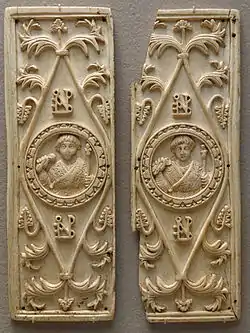Imago clipeata
Imago clipeata (Latin: "portrait on a round shield") is a term in the art history of ancient Rome for images of ancestors, famous people or deceased shown as on a round shield (in Latin: clipeus).[1] For other periods similar forms are called medallions. In the Roman world the imago clipeata was used to depict the ancestral family tree (Latin: Stemma) in patrician houses of the Roman Republic as described by Pliny the Elder (Historia Naturalis 35: 4–11).[2][3]

These shield portraits can be seen in architectural sculptural decorations, on sarcophagi and on standards of the Roman legions among many other types of representations in the Roman and Early Christian world. In Italian Baroque imagery, medallion portraits supported by nymphs or genii came to signify an apotheosis. In this context they might be called tondi.
References
- "Description and reproduction of Imago clipeata at the Forum of Augustus on the Athenian Acropolis". Archived from the original on 2005-04-12. Retrieved 2005-04-04.
- Winkes, Rolf (1969). Clipeata imago. Bonn.
{{cite book}}: CS1 maint: location missing publisher (link) - Winkes, Rolf (1979). "Pliny's chapter on Roman funeral customs in the light of Clipeatae imagines". American Journal of Archaeology. 83 (4): 481–484. doi:10.2307/504152. JSTOR 504152. S2CID 192963318.